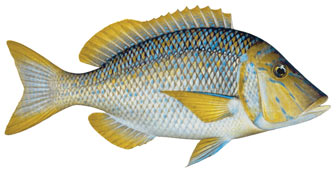
The spangled emperor (Lethrinus nebulosus) is sometimes called north-west snapper or yellow emperor. It belongs to the Lethrinidae family, which also includes sea bream and large-eye bream. Known as Lethrinids, they have robust teeth at the front and side of the jaws, and cheeks without scales. They are carnivorous, bottom-feeding fish.
The spangled emperor can live for more than 30 years. It can grow to 800 mm and 8 kg. It has a golden-brown body with blue spots on the scales of the upper body and blue bars or lines radiating from the eyes over the cheeks and snout.
It can change colour by switching on pigment cells in its skin. When an emperor is frightened, it often produces blotchy vertical brown bands across its body. It can have one colour pattern when taken out of the water and develop another over the following minutes. This can make  identification of the species quite difficult.
identification of the species quite difficult.
The spangled emperor has been named an ‘indicator species’ in the Gascoyne Coast Bioregion (from north of Kalbarri to the Ashburton River). This means its stock status, along with the status of several other indicator species, is used to indicate the status of all demersal (bottom-dwelling) fish in the region.
Distribution and habitat
Lethrinids are found mostly in the tropical waters of the Indo-Pacific region.
In Western Australia, spangled emperor are found mainly in northern waters. However, they can sometimes be found as far south as Rottnest Island.
They are reef dwellers – ranging from shallow coral reefs and seagrass beds to deep rocky reefs 200 m deep.
Illustration © R. Swainston/www.anima.net.au